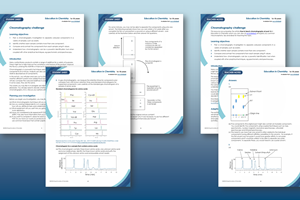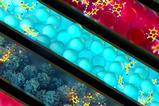Use the context of sweets to research analytical techniques and their applications
This resource accompanies the CPD article How to teach chromatography at post-16 in Education in Chemistry, where you will find tips, common misconceptions and further ideas for building learners’ understanding of chromatography and its applications.
Learning objectives
- Plan a chromatography investigation to separate coloured components in a variety of samples, such as sweets.
- Identify whether each sample contains more than one component.
- Compare and contrast the components from each sample using Rf values.
- Understand how chromatography can be a powerful identification tool when coupled with other analytical techniques, eg spectrometry and spectroscopy.
Introduction
Many confectionery products contain additives for a variety of purposes. These might be to help improve the consistency and texture of the product, improve the flavour, prolong the shelf life or improve the appearance, often by adding dyes.
This resource provides learners with opportunities to apply their understanding of chromatography principles, and plan and carry out an investigation using the known context of sweets. They will identify and compare the coloured additives in various sweets and decide whether the dyes used by different manufacturers are the same. Learners will then work through a research activity and assess their understanding via the questions. Find the answers in the Teacher notes.
A similar version of this resource, designed for 11–14 year-old learners, also explores the Chromatography of sweets. Use the scaffolded worksheets with your younger classes, or provide the investigation’s procedure to give your 16–18 learners more support instead of asking them to plan their own experiments.
You may like to provide M&M’s®, Smarties®, red liquorice and jellybeans. Remind learners they must not eat or lick the sweets as they are for laboratory use only. You could allow learners to choose other products to investigate. They will also need to decide if they want to use paper or thin-layer chromatography (TLC).
Technician notes
Read our Standard health and safety guidance and carry out a risk assessment before running any live practical.
As this is a planning investigation, learners may request alternative equipment to the suggested list in the Teacher notes. Download the document to find preparation tips, safety and hazards, and disposal information. Importantly, check packaging for any possible allergens or hazards. Do not use peanut M&M’s due to the risk of allergic reaction.
Planning the investigation
Before learners begin their investigation, ask them to consider the following questions:
- What chromatography technique will you use: paper chromatography or TLC?
- Are you working independently or in a group? If you decide to work with others, how will you distribute tasks and collaborate?
- What equipment will you use? Are you going to do repeats? If so, you may need more apparatus.
- Have you considered a risk assessment? CLEAPSS has student safety sheets and SSERC may also have information that you can apply to your investigation.
- If you want to compare Rf values for each component, do you know how to do this? Do you have (or could you produce) standards for food colourings? (Maybe use common food dyes that contain paprika, turmeric and anthocyanins).
You may want to adapt these questions for your learners, either as a whole group or for smaller groups/individuals.
Once learners have produced and analysed their chromatograms, ask them questions to help them draw conclusions. For example, ask what coloured dyes different sweets contain? Are the dyes used in different sweets the same?
More resources
- Highlight What analytical chemists do and the different sectors they work in, such as food and pharmaceuticals.
- Get hands on with TLC to investigate the photosynthetic pigments of plants or to analyse paracetamol in your post-16 lessons.
- Show your students how chemists at the National Gallery in London use chromatography to restore art works.
- Use the Structure determination question and answer sheet to test learners’ knowledge of chromatography, spectrometry and spectroscopy.
Get learners to write up their findings as a scientific report (they may need to research what this looks like, or they may prefer to create their own style) or poster. You could provide a template, such as the Teaching science skills: presenting investigations PowerPoint, to scaffold this task.
Research activity
It is important that learners understand that chromatography is just one of a range of techniques chemists use when they want to separate and identify components in a mixture. They will research other analytical techniques, such as mass spectrometry, infrared spectroscopy, ultraviolet spectroscopy and nuclear magnetic resonance spectroscopy that chemists use to help identify colour components.
Remind learners that chemists can only use chromatography to identify components using Rf values if these are standardised. Chromatography can also be useful in estimating relative abundances of components in a mixture. Scientists can use a range of analytical techniques for identification of components once they’ve separated the mixtures. They can use combinations of techniques very effectively to identify reaction products, for example in the synthesis of medicines, and in forensic science.
Downloads
Chromatography challenge student sheet
Handout | PDF, Size 0.52 mbChromatography challenge teacher notes
Handout | PDF, Size 0.26 mbChromatography challenge student sheet
Editable handout | Word, Size 0.81 mbChromatography challenge teacher notes
Editable handout | Word, Size 0.53 mb
























No comments yet